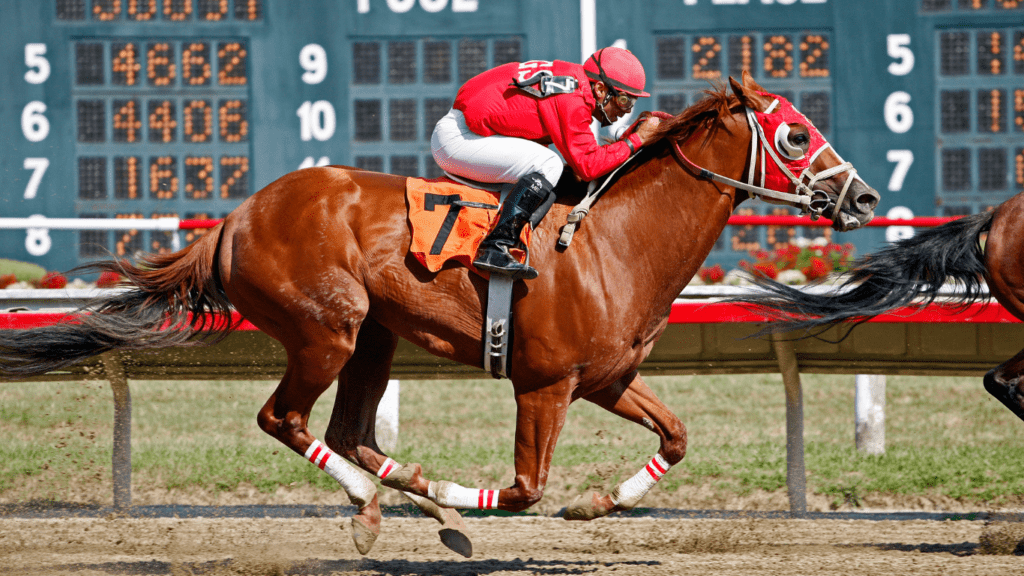Understanding Horse Racing
Horse racing involves various factors that can influence the outcome and betting strategies. Proper understanding enhances the chances of making accurate predictions.
The Basics of Horse Racing
In horse racing, a race involves horses running a set distance on a track. Races vary by distance and track conditions. Thoroughbreds, quarter horses, and standardbreds are common breeds in different types of races.
Races can be flat or include obstacles like hurdles or fences. Flat racing emphasizes speed, while jump racing tests endurance and jumping ability.
Jockeys play a vital role in steering and pacing the horse during the race. Experienced jockeys often make strategic decisions in seconds to gain an edge.
- Handicap: A race where horses carry different weights to level the playing field. Weights are assigned based on past performance.
- Furlong: A unit of measure equal to one-eighth of a mile (220 yards). Thoroughbred races often use this term.
- Post Position: The starting gate position of a horse. Some positions may offer advantages based on track layout.
- Form Guide: A document that provides past performance data on horses, jockeys, and trainers. Bettors rely on form guides for informed decisions.
- Odds: The likelihood of a horse winning, reflected in betting returns. Short odds indicate favorites, while long odds show underdogs.
Understanding these terms and basics equips bettors to make more informed decisions when placing bets. Proper knowledge reduces the uncertainty and can lead to more successful outcomes.
Assessing Race Conditions
Understanding race conditions is crucial for picking winners in horse racing bets. Track surfaces and weather can significantly influence race outcomes.
Analyzing Track Surfaces
Track surfaces vary and impact horse performance. Dirt, turf, and synthetic are the main types.
- Dirt Tracks: Common in the US, dirt tracks suit horses with speed and endurance. Track condition categories include fast, good, muddy, and sloppy. Each category affects speed; for instance, muddy tracks slow down horses.
- Turf Tracks: Preferred in Europe and Asia, turf tracks require agility and balance. Firm, good, yielding, and soft are condition categories. Firm turf suits fast horses, while soft turf favors those with stamina.
- Synthetic Tracks: These mimic dirt but reduce injury risks. Popular types include Polytrack and Tapeta. Synthetic tracks have consistent conditions, favoring adaptable horses.
Weather Impact on Races
Weather changes influence track conditions and horse performance.
- Rain: Rain impacts dirt and turf tracks differently. Dirt turns muddy or sloppy, enhancing stamina’s importance. Turf becomes yielding or soft, favoring durable horses.
- Heat: High temperatures strain horses, reducing performance. Hydration and fitness become vital. Trainers often use cooling strategies.
- Wind: Strong winds affect race dynamics. Headwinds slow horses, while tailwinds speed them up. Wind direction requires strategic adjustments.
Evaluating race conditions improves betting accuracy. Understanding surfaces and weather offers a competitive edge.
The Art of Reading Racing Forms
Reading racing forms is critical for making informed betting decisions. By mastering the interpretation of these forms, bettors gain insights into horse performance and potential race outcomes.
Understanding Form Guides
Understanding form guides helps identify horse performance trends. A form guide contains data from a horse’s past races, such as finishing positions, race distances, track conditions, and winning margins.
For instance, a sequence like “1-3-2-5” represents finishes across the last four races.
Analyzing this sequence reveals performance consistency and potential for improvement. Add context-specific details, including jockey changes and equipment variations, to uncover patterns that influence outcomes.
The Significance of Jockey and Trainer Stats

Jockey and trainer stats play a pivotal role in evaluating race prospects. Certain jockeys have higher win rates, especially on specific tracks or with particular trainers.
For example, if a jockey has a 25% win rate at a specific track, their mounts become more attractive bets. Trainer stats, such as winning percentages with first-time starters or horses coming off a layoff, indicate their ability to prepare horses for specific conditions.
Combining these stats with horse form guides creates a comprehensive view, enhancing the probability of selecting winners.
Betting Strategies
Effective betting strategies can significantly impact your success in horse racing. Understanding different bet types and insider tips can improve your predictions.
Types of Bets in Horse Racing
Betting in horse racing offers several options. Here are the main types:
- Win Bet: Predict which horse finishes first.
- Place Bet: Predict if a horse finishes first or second.
- Show Bet: Predict if a horse finishes in the top three.
- Exacta Bet: Predict the first two horses in exact order.
- Trifecta Bet: Predict the first three horses in exact order.
- Superfecta Bet: Predict the first four horses in exact order.
Understanding these bet types can help diversify your betting strategy and manage risks effectively.
Practical Betting Tips from Insiders
Experienced bettors use several practical strategies:
- Research Thoroughly: Analyze form guides, horse performance trends, and jockey stats to identify strong contenders.
- Consider Track Conditions: The state of the track can affect horse performance. Wet tracks might favor certain horses, while dry tracks suit others.
- Manage Your Bankroll: Set a budget for your bets and stick to it. Avoid chasing losses by making impulsive bets.
- Follow Historical Data: Horses and jockeys often perform consistently at certain tracks. Use historical data for insights.
- Stay Informed: Keep up with news about trainers, owners, and any changes in horse conditions. Unexpected factors can influence outcomes.
Utilizing these tips enhances your chances of making informed, successful bets.
Managing Your Betting Bankroll
Managing a betting bankroll ensures you stay in control and sustain long-term betting success. Several steps are fundamental for effective bankroll management.
Setting a Budget
Setting a budget is the first step in managing your betting bankroll. Allocate a specific amount each month for betting, considering your overall financial situation.
Only use money you can afford to lose—never dip into essential funds. For instance, if your monthly allowance for entertainment is $500, you might decide to allocate $100 for horse racing bets. This allocation helps maintain balance and prevents financial strain.
Importance of Record Keeping
Record keeping is essential for tracking performance and making data-driven decisions. Maintain detailed records of all bets placed, including the amount wagered, the type of bet, the horse, the race, and the outcomes.
Use a spreadsheet or a dedicated app to log this information.
For example, noting that you bet $20 on a win bet for Race 3 at Belmont Park and won $60 helps identify profitable patterns. Reviewing these records over time can reveal which strategies work best, helping refine future bets.



